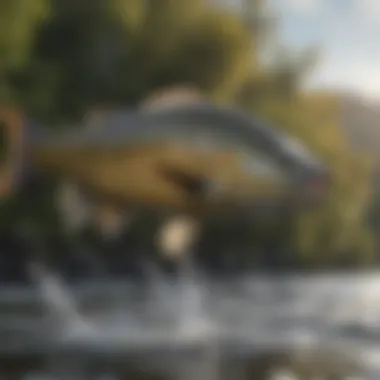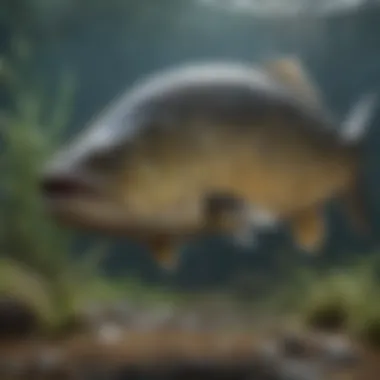Unveiling the Enigmatic Realm of Chinook Fish: A Comprehensive Exploration


Overview of the Topic
Current Status and Challenges
In exploring the current status of Chinook fish, it becomes evident that these majestic creatures face a myriad of challenges and threats. Factors such as habitat destruction, overfishing, and climate change significantly impact their populations, endangering not only the species itself but also the intricate web of life they support in freshwater and marine environments.
Sustainable Solutions
Amidst these challenges lies the potential for sustainable solutions to secure the future of Chinook fish populations. By promoting responsible fishing practices, habitat restoration efforts, and proactive conservation measures, there is a ray of hope to mitigate the adverse effects and ensure the long-term viability of these iconic creatures. Case studies highlighting successful resource management initiatives serve as beacons of inspiration for effective conservation strategies.
Impact and Importance
The impact of Chinook fish transcends beyond their individual presence in aquatic ecosystems, profoundly influencing both the natural world and human communities. Their conservation is not merely a matter of preserving a species but safeguarding the intricate balance of entire ecosystems, as well as the cultural and economic significance they hold for various societies. Recognizing the importance of conservation efforts and sustainable resource use is paramount to ensure that future generations can continue to marvel at the magnificence of Chinook fish in the ever-evolving tapestry of nature.
Introduction to Chinook Fish
Chinook fish, also known as king salmon, are a captivating subject worthy of exploration in this article. Their significance lies in their vital role within aquatic ecosystems, serving as indicators of environmental health and biodiversity. Understanding these majestic creatures provides key insights into the delicate balance of nature and the impacts of human activities on aquatic life. Readers will delve into a nuanced study of Chinook fish, gaining a deep appreciation for their unique characteristics and ecological importance.
Overview of Chinook Fish
Chinook fish, scientifically named Oncorhynchus tshawytscha, belong to the salmon family and are renowned for being the largest Pacific salmon species. These magnificent fish can reach impressive sizes, with some specimens exceeding 100 pounds in weight. Their distinctive lifecycle, including their epic upstream migrations for spawning, sets them apart from other fish species. Chinook fish are highly prized not only for their size but also for their delicious flesh, contributing to their commercial and recreational significance.
Historical Significance
Throughout history, Chinook fish have held immense cultural and economic importance for indigenous communities and early settlers. Native American tribes revered these fish as symbols of strength, resilience, and abundance, incorporating them into traditional folklore and ceremonies. The historical significance of Chinook fish extends to the vital role they played in sustaining early settlements along rivers and coastlines, providing a crucial food source and supporting local economies.
Importance in Native Cultures
Chinook fish carry profound cultural significance for indigenous communities, symbolizing sustenance, spiritual connection, and environmental stewardship. In Native American traditions, the annual return of Chinook fish signifies renewal and the cyclical nature of life. Rituals and ceremonies surrounding the fishing season reflect a deep respect for nature and the interconnectedness of all living beings. The presence of Chinook fish continues to enrich and preserve the cultural heritage of indigenous peoples across the Pacific Northwest.
Distinctive Features


What sets Chinook fish apart are their robust bodies, vibrant coloring, and distinct morphology. These fish exhibit an iconic silhouette with a smoothly curved back and a pointed snout, perfectly adapted for swift movement through fast-flowing waters. Their scales shimmer with hues of silver, blue, and green, creating a mesmerizing sight in the sunlight. Chinook fish also boast a keen sense of smell and taste, crucial for navigating vast oceanic environments and identifying suitable habitats for feeding and spawning.
Habitat and Distribution
Natural Habitat of Chinook Fish
The natural habitat of Chinook fish primarily includes freshwater ecosystems such as rivers, streams, and lakes. These salmon species exhibit anadromous behavior, migrating between freshwater and saltwater environments during different life stages. They rely on clean and well-oxygenated water for spawning and juvenile development. Their habitat features diverse vegetation, suitable gravel beds for nesting, and adequate food sources to support their growth. Understanding their natural habitat is crucial for implementing conservation measures that ensure the preservation of these vital ecosystems.
Global Distribution
Chinook fish have a diverse global distribution spanning regions across the Northern Pacific Ocean, including North America and Asia. Their distribution extends from California to Alaska in North America and from Japan to the Kamchatka Peninsula in Asia. This widespread distribution showcases the adaptability of Chinook fish to a range of environmental conditions and habitats. By exploring their global distribution, we uncover the interconnectedness of Chinook populations worldwide and the significance of international conservation efforts to protect their diverse habitats.
Migration Patterns
Migration patterns play a pivotal role in the life cycle of Chinook fish, influencing their breeding success and population sustainability. These fish undertake extensive migration journeys, navigating vast distances from their freshwater spawning grounds to the open ocean and back. The migration patterns of Chinook fish are governed by various factors such as water temperature, food availability, and reproductive instincts. Studying their migration patterns offers valuable insights into their behavior, physiology, and the challenges they face during their epic journeys. By examining migration patterns, researchers and conservationists can develop strategies to safeguard and preserve these unique migratory routes.
Chinook Fish Diet and Feeding Behavior
In this segment of the article, we are going to explore the critical topic of Chinook Fish Diet and Feeding Behavior, shedding light on the intricate relationship between what these majestic creatures consume and how they feed. Understanding the dietary habits and feeding behaviors of Chinook fish is paramount in comprehending their overall ecological role and conservation requirements.
Primary Food Sources
Chinook fish have a diverse diet, primarily consisting of aquatic insects, small fish, and plankton. These main food sources provide essential nutrients for the Chinook's growth and survival. The consumption of these different food types allows Chinook fish to adapt to varying environmental conditions. They are opportunistic feeders, meaning they can consume a wide range of prey based on availability and habitat. By feeding on a variety of organisms, Chinook fish play a crucial role in maintaining the balance of the aquatic ecosystem.
Feeding Behavior
Chinook fish exhibit different feeding behaviors depending on their developmental stage and environmental factors. Juvenile Chinook are known to feed on zooplankton and small aquatic invertebrates in freshwater habitats, while adult Chinook target larger prey like fish and squid when migrating to the ocean. Their feeding behavior is influenced by factors such as water temperature, turbidity, and prey abundance. Understanding these feeding patterns is essential for predicting Chinook fish distribution and abundance in different habitats.
Impact of Diet on Growth
The diet of Chinook fish directly impacts their growth rate and overall health. A balanced diet rich in protein and essential nutrients is crucial for their development from fry to adult stage. Variations in diet quality and quantity can affect their growth potential and reproductive success. Moreover, environmental factors like pollution and habitat degradation can alter the availability of their food sources, posing threats to the Chinook fish population. By examining the impact of diet on Chinook fish growth, researchers can implement conservation strategies to ensure their long-term survival in changing ecosystems.
Conservation Status and Threats


Conservation status and threats play a pivotal role in understanding the survival challenges faced by the Chinook fish species. Protecting these majestic creatures is crucial for maintaining biodiversity and ecological balance. Conservation efforts are essential to prevent the decline of Chinook populations, ensuring their existence for future generations.
Current Conservation Efforts
Several conservation initiatives have been implemented to safeguard Chinook fish populations. These efforts include habitat restoration projects, fishery regulations, and monitoring programs to track population trends. Collaboration between governmental agencies, conservation organizations, and local communities is vital in executing effective conservation strategies.
Threats to Chinook Fish Population
The Chinook fish face numerous threats that endanger their populations. Overfishing, habitat destruction due to urban development, pollution, and climate change pose significant challenges to their survival. By addressing these threats through proactive measures, we can mitigate the risks and protect these species from further decline.
Role of Climate Change
Climate change has emerged as a profound threat to Chinook fish populations. Rising water temperatures, altered river flows, and habitat degradation directly impact their spawning patterns and migration routes. Adapting to these environmental changes is crucial for the long-term survival of Chinook fish. Implementing sustainable practices and reducing carbon emissions are essential steps in combating the detrimental effects of climate change on these iconic species.
Economic and Ecological Importance
In the realm of Chinook fish exploration, delving into their economic and ecological significance unveils a tapestry of interconnected relationships that underscore their importance in both human commerce and ecosystem sustainability. Understanding the economic and ecological dimensions of these awe-inspiring creatures is paramount to appreciating their full impact on our world.
Commercial Value
Chinook fish, esteemed for their delectable flesh and rich nutrient content, hold a significant commercial value in the fishing industry. Their meat, prized for its quality and taste, commands a premium price in markets worldwide. Whether served fresh in luxury restaurants or processed into various culinary delights, the Chinook fish's commercial value extends across different sectors, contributing to economic growth and culinary appreciation.
Ecological Role in Ecosystem
Beyond their economic worth, Chinook fish play a pivotal ecological role in maintaining marine ecosystems' delicate balance. As apex predators, they regulate prey populations, preventing overpopulation and ecosystem degradation. Moreover, their nutrient-rich bodies serve as a vital source of food for other marine organisms, ensuring a harmonious food web and promoting biodiversity. The presence of Chinook fish in aquatic environments signifies a healthy ecosystem, emphasizing the interconnectedness of all species in nature's intricate web of life.
Research and Study of Chinook Fish
Chinook fish, also referred to as king salmon, are subjects of intensive research and study due to their significant ecological and economic importance. Understanding the behavior, genetics, and overall biology of Chinook fish is crucial for effective conservation efforts and sustainable management of their populations. This section delves into the various aspects of research and study revolving around these majestic creatures.
Scientific Research Projects
Scientists and researchers worldwide conduct numerous scientific research projects to delve deep into the life of Chinook fish. These projects aim to study their migration patterns, breeding behaviors, habitat preferences, and responses to environmental changes. By analyzing data collected from tagging studies, telemetry research, and population assessments, researchers can draw valuable insights into the life cycle and ecological requirements of Chinook fish.


Behavioral Studies
Behavioral studies play a pivotal role in unraveling the mysteries surrounding Chinook fish. Researchers observe their social interactions, feeding habits, predator avoidance strategies, and mating behaviors to comprehend their role in the ecosystem better. By conducting experiments in controlled environments and observing fish in their natural habitat, scientists can gather essential data on the behavioral patterns and adaptations of Chinook fish.
Genetic Studies
Genetic studies are instrumental in determining the genetic diversity, population structure, and evolutionary history of Chinook fish populations. By analyzing DNA samples from different stocks and populations, researchers can assess levels of genetic variation, gene flow patterns, and the potential impact of inbreeding. Understanding the genetic composition of Chinook fish populations is vital for implementing effective conservation strategies and maintaining the long-term viability of these iconic species.
Future Outlook for Chinook Fish
The 'Future Outlook for Chinook Fish' section of this extensive article on Chinook fish delves into the critical aspects that forecast the trajectory of these majestic creatures. Tackling various elements regarding the future of Chinook fish is essential for understanding their sustainability and conservation.
In considering the Future Outlook for Chinook Fish, it is imperative to assess the current challenges, potential advancements, and the overall outlook for these remarkable species. By examining the future prospects of Chinook fish, we can better comprehend the measures required to ensure their survival and flourishing in the ecosystem.
Sustainability Concerns
When addressing the Sustainability Concerns related to Chinook fish, we confront an array of pressing issues that directly impact their well-being and existence. The depletion of natural habitats, pollution, overfishing, and climate change pose significant threats to the sustainability of Chinook fish populations.
Ensuring the sustainability of Chinook fish necessitates collective conservation efforts, habitat restoration, stricter regulations on fishing practices, and raising awareness about the importance of preserving these iconic species. Mitigating sustainability concerns is crucial for maintaining the delicate balance of aquatic ecosystems and safeguarding the future of Chinook fish.
Projections for Population Trends
Analyzing the Projections for Population Trends of Chinook fish sheds light on the expected changes in their numbers and distribution over the coming years. Scientists and conservationists project varying trends influenced by factors such as environmental conditions, human activities, and conservation initiatives.
By forecasting the Population Trends of Chinook fish, researchers can anticipate potential challenges, implement targeted conservation strategies, and monitor the effectiveness of conservation measures. Tracking population trends is essential for assessing the success of conservation efforts and adapting management strategies accordingly.
Adaptive Strategies
Delving into the realm of Adaptive Strategies for Chinook fish involves exploring the diverse methods and approaches aimed at enhancing their resilience and survival in the face of environmental challenges. Adaptive strategies encompass a range of initiatives, including habitat restoration, breeding programs, genetic diversity conservation, and sustainable fishing practices.
Implementing effective Adaptive Strategies is key to ensuring the long-term viability of Chinook fish populations and preserving their genetic diversity. By adapting to changing environmental conditions and human impacts, Chinook fish can thrive in their natural habitats and continue to play a crucial role in aquatic ecosystems.
Future Outlook for Chinook Fish
In this segment, we embark on a crucial exploration of the future outlook for Chinook fish, shedding light on the sustainability concerns that loom over these majestic creatures. As environmental stewards, it is imperative to delve into the projections for population trends and consider adaptive strategies to ensure the continuity of Chinook fish populations.
Summary of Key Points
The future outlook for Chinook fish is a topic of paramount importance, resonating throughout this article. We dissect the sustainability concerns impacting these remarkable creatures and delve deep into projections for population trends. By scrutinizing the various aspects of their habitat, diet, and conservation status, we paint a comprehensive picture of the challenges and opportunities in securing the future of Chinook fish populations.



